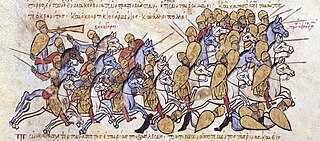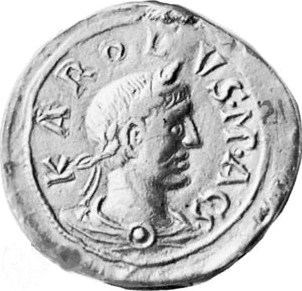
Arnulf of Carinthia was the duke of Carinthia who overthrew his uncle, Emperor Charles the Fat, became the Carolingian king of East Francia from 887, the disputed King of Italy from 894 and the disputed Holy Roman Emperor from February 22, 896 until his death at Regensburg, Bavaria.

Year 894 (DCCCXCIV) was a common year starting on Tuesday of the Julian calendar.

Carloman was a Frankish king of the Carolingian dynasty. He was the eldest son of Louis the German, king of East Francia, and Hemma, daughter of a Bavarian count. His father appointed him governor of Carantania in 856, and commander of southeastern frontier marches in 864. Upon his father's death in 876 he became King of Bavaria. He was appointed by King Louis II of Italy as his successor, but the Kingdom of Italy was taken by his uncle Charles the Bald in 875. Carloman only conquered it in 877. In 879 he was incapacitated, perhaps by a stroke, and abdicated his domains in favour of his younger brothers: Bavaria to Louis the Younger and Italy to Charles the Fat.

Charles III, also known as Charles the Fat, was the emperor of the Carolingian Empire from 881 to 888. A member of the Carolingian dynasty, Charles was the youngest son of Louis the German and Hemma, and a great-grandson of Charlemagne. He was the last Carolingian emperor of legitimate birth and the last to rule over all the realms of the Franks.

Great Moravia, or simply Moravia, was the first major state that was predominantly West Slavic to emerge in the area of Central Europe, possibly including territories which are today part of the Czech Republic, Slovakia, Hungary, Austria, Germany, Poland, Romania, Serbia and Ukraine. The only formation preceding it in these territories was Samo's tribal union known from between 631 and 658 AD.
Aribo was margrave of the Carolingian March of Pannonia from 871 until his death. He is recognised as a progenitor of the Aribonid dynasty.

Svatopluk I or Svätopluk I, also known as Svatopluk the Great, was a ruler of Great Moravia, which attained its maximum territorial expansion during his reign.

Guy III of Spoleto was the margrave of Camerino from 880 and then duke of Spoleto and Camerino from 883. He was crowned king of Italy in 889 and emperor in 891. He died in 894 while fighting for control of the Italian Peninsula.

Luitpold, perhaps of the Huosi family or related to the Carolingian dynasty by Liutswind, mother of Emperor Arnulf of Carinthia, was the ancestor of the Luitpolding dynasty which ruled Bavaria and Carinthia until the mid-tenth century.
Braslav was a prince who ruled the Slavs in Lower Pannonia, in a territory located mostly in modern-day Croatia, between 884 and 896 as a vassal of Arnulf of Carinthia. He participated in the Frankish–Moravian War (882–84) and the Frankish invasion of Moravia (891–92). He was last mentioned when he was entrusted Pannonia by Arnulf in order to secure the Frankish frontier against the Hungarians (896), who subsequently overran all of Pannonia and continued into Italy.
The Luitpoldings were a medieval dynasty which ruled the German stem duchy of Bavaria from some time in the late ninth century off and on until 985.
William (II) was the margrave of the March of Pannonia in the mid ninth century until his death on campaign against the Moravians in 871. In his day, the march orientalis corresponded to a front along the Danube from the Traungau to Szombathely and the Rába river and including the Vienna basin. It was a military frontier zone against Avaria.
Engelschalk I was the margrave of the March of Pannonia in the mid ninth century until his death on campaign against the Moravians in 871. In his day, the march orientalis corresponded to a front along the Danube from the Traungau to the Szombathely and Raba rivers and including the Vienna basin. It was a military frontier zone against Great Moravia.
Engelschalk II was the margrave of the March of Pannonia in the late ninth century in opposition to Aribo. In his day, the march orientalis corresponded to a front along the Danube from the Traungau to the Szombathely and Raba rivers and including the Vienna basin.

The March of Carinthia was a frontier district (march) of the Carolingian Empire created in 889. Before it was a march, it had been a principality or duchy ruled by native-born Slavic princes at first independently and then under Bavarian and subsequently Frankish suzerainty. The realm was divided into counties which, after the succession of the Carinthian duke to the East Frankish throne, were united in the hands of a single authority. When the march of Carinthia was raised into a Duchy in 976, a new Carinthian march was created. It became the later March of Styria.

The March of Pannonia or Eastern March was a frontier march of the Carolingian Empire, named after the former Roman province of Pannonia and carved out of the preceding and larger Avar march.
The history of Moravia, one of the Czech lands, is diverse and characterized by many periods of foreign governance.
The Wilhelminers were a noble Bavarian family of the 9th century. They rose to prominence mid-century under the brothers William and Engelschalk I, sons of William I, the founder of the family. The family held the March of Pannonia until 871, but their possession of it was the cause of a dispute, the Wilhelminer War, with the Aribonids. In the dispute the Wilhelminers had the support of Arnulf of Carinthia and Svatopluk of Moravia.
The Aribonids were a noble family of probably Bavarian origin who rose to preeminence in the Carolingian March of Pannonia and the later Margraviate of Austria in the late ninth and early tenth centuries. The dynasty is named after its ancestor Margrave Aribo of Austria. The Aribonids maintained influence in the Duchy of Bavaria, the Austrian march, and other parts of Germany until the early twelfth century, when they disappear.
In 882–84, a bloody war was fought between Arnulf of Carinthia and Svatopluk I of Moravia, during which Pannonia and the Danube suffered the most. Svatopluk is said to have "slaughtered" and "destroyed much with fire and sword". The two sides reached an agreement on peace in 884 at Tulln.